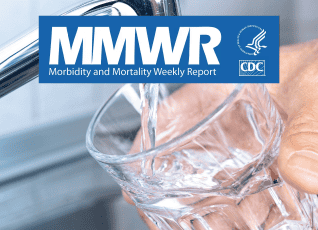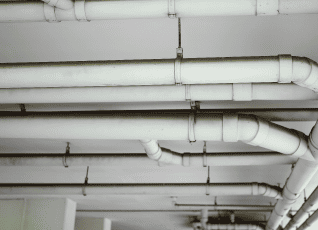How Weather, Climate, and Water Sources Impact Waterborne Disease Hospitalizations

A recent study from Columbia University, published in the open-access journal PLOS Water, investigates how weather conditions, climate, and water sources affect hospital admissions for waterborne infectious diseases in the United States. The study examined 12 years of data from 516 hospitals in 25 states. Key findings on biofilm-forming bacteria Biofilm-forming pathogens, such as Legionella, Pseudomonas, and Nontuberculous mycobacteria (NTM), thrive in biofilms within water distribution systems and are responsible for respiratory infections, especially among vulnerable populations like individuals over 55 or those who are immunocompromised. During the study period, biofilm-forming bacteria were responsible for 81% of all waterborne disease hospitalizations. Geographical and environmental influences Conclusion The study identifies a clear link between meteorological conditions, drinking water sources, and hospitalization rates for waterborne diseases. With climate change potentially leading to more extreme weather events, the study highlights the need for improved water infrastructure and water management practices to mitigate the risk of these waterborne infections, particularly in urban areas and regions dependent on groundwater sources.
Legionella: What Is It and How to Control It

What is Legionella? Legionella is a bacterium that causes Legionnaires’ disease and Pontiac fever. It was named after the first known outbreak of Legionnaires’ disease in 1976 at an American Legion Convention. Legionnaires’ disease is a severe type of pneumonia. Pontiac fever is a less severe illness that typically resolves without hospitalization. Approximately 90% of Legionnaires’ disease cases are caused by Legionella pneumophila. Non-pneumophila species are responsible for fewer than 10% of cases. Where is it found? Legionella can be found in natural water sources. It can survive traditional municipal water treatment processes and be distributed to buildings from the municipal water supply. Once in building water systems, ideal conditions, like warm water, sediment, and other microorganisms, can cause it to proliferate. Potable water systems, especially hot water systems, are the highest concern for Legionella growth and transmission. High-risk non-potable systems include cooling towers, decorative water features, whirlpools, spas, and misters. More than half of outbreaks occur in healthcare facilities. Outbreaks have also been linked to nursing homes, hotels, workplaces, apartment complexes, and community sources. What are the health concerns? Legionnaires’ disease can be contracted through exposure to contaminated water, usually via inhalation of aerosolized particles or aspiration. Cases have also been linked to direct installation, such as nasogastric tubes. People with weakened immune systems, chronic lung disease, diabetes, cancer, transplants, steroid use, and the elderly are at higher risk of contracting the disease. However, roughly 25% of cases have no known risk factors. More than 95% of cases require hospitalization, and more than 30% require admission to the ICU. The disease fatality rate is over 10%. Healthcare facilities are the most common exposure setting, accounting for 57% of cases and 85% of deaths. How can Legionella be controlled? There are many strategies to reduce Legionella risk in building water systems. To start, Legionella testing should be conducted to identify if and where Legionella is present in the water system so evidence-based remediation strategies can be implemented. Continuous supplemental disinfection can be installed to remediate the entire water system and provide long-term Legionella control. The most effective is copper-silver ionization. It is highly effective against Legionella and other waterborne pathogens and does not have any negative side effects, like corrosion or harmful disinfection byproducts. Short-term remediation options, like chlorine shock treatments, have varying efficacy. If Legionella reduction is achieved, it is typically short-lived. Point-of-use filters can be installed on faucets, showerheads, and ice machines to prevent exposure to Legionella and other waterborne pathogens. However, they do not remediate the water system and require ongoing maintenance and costs, so they are usually deployed temporarily or in high-risk units. Engineering controls like circulation, flushing, and temperature can prevent favorable conditions but do not fully mitigate risk. These controls should be used in conjunction with other strategies. A water management plan and routine Legionella testing should be utilized to help evaluate and manage ongoing Legionella risks in building water systems. Download: Legionella fact sheet Fill out the form below to download our Legionella fact sheet to keep on hand or to share with your team.
Waterborne Pathogens a Growing Concern in US Drinking Water, CDC Report Shows

The Centers for Disease Control and Prevention (CDC) has released a report summarizing waterborne disease outbreaks in the United States between 2015 and 2020. The report Surveillance of Waterborne Disease Outbreaks Associated with Drinking Water includes data voluntarily reported by public health agencies to the CDC through the National Outbreak Reporting System (NORS). Data reported includes the waterborne pathogen implicated, outbreak-contributing factors (i.e., practices and factors that lead to outbreaks), and the setting of exposure (e.g., hospital or health care facility; hotel, motel, lodge, or inn). Outbreaks from drinking water During the surveillance period, 214 outbreaks associated with drinking water were reported, resulting in at least: The report found that 80% of outbreaks were linked to public water systems, including municipal water systems or water systems that serve an institution, camp, park, hotel, or business. The remaining outbreaks were linked to unknown water systems (10%), individual or private systems (8%), and other systems (.9%). Most implicated waterborne pathogen: Legionella Legionella caused 98% of biofilm-associated outbreaks, followed by nontuberculous mycobacteria (NTM) at 1% and Pseudomonas at 0.5%. Over the study period, the number of Legionella-associated outbreaks increased, with Legionella being the most common cause of public water system outbreaks, responsible for 92% of outbreaks, 97% of hospitalizations, and 97% of related deaths. Leading contributing factor: Building plumbing systems Building plumbing systems were the most cited contributing factor type for all biofilm-associated pathogen outbreaks. The most reported building plumbing contributing factors were: Out of 214 reported outbreaks, 183, or 86%, included information on water treatment. Among these outbreaks, 116 (54%) drinking water systems reported using disinfection as a water treatment method, 49 (23%) systems had an unknown water treatment, and 17 (8%) drinking water systems reported having no water treatment at all. Chlorine was the most used disinfection method and was used in 37% of all outbreaks. Chloramine was used in 6% of outbreaks, while the remaining outbreaks either used an unknown water disinfection method or the method was not listed. Most common exposure settings: Hospitals and hotels Healthcare facilities (e.g., hospitals, long-term care, assisted living, or rehabilitation facilities) were identified as the exposure setting in 53% of outbreaks, causing 66% of hospitalizations and 87% of deaths. Legionella was implicated in over half of the healthcare-associated outbreaks, causing 65% of hospitalizations and 85% of deaths. Hotels, motels, lodges, or inns were the second highest exposure setting for outbreaks. They were implicated in 16% of outbreaks, all of which were caused by Legionella. Importance of water treatment and management in preventing outbreaks The CDC report highlights the growing concern of waterborne pathogens in US drinking water. Legionella was identified as the most common waterborne pathogen, causing the majority of biofilm-associated outbreaks and being responsible for the highest number of public water system outbreaks, hospitalizations, and related deaths. Effective water treatment and management of building plumbing systems is critical to prevent outbreaks and ensure safe drinking water in healthcare and non-healthcare settings. ReferencesCenters for Disease Control and Prevention. (2024). Surveillance of Waterborne Disease Outbreaks Associated with Drinking Water — United States, 2015–2020. Morbidity and Mortality Weekly Report | CDC
Legionella Bacteria Water Sampling Methodology

This blog delves into systematic approaches for Legionella water testing, offering valuable insights into best practices and recommendations to ensure the safety of your water. Importance of quarterly Legionella sampling Building water systems are dynamic and influenced by various factors such as usage patterns, maintenance schedules, and seasonal changes in municipal water quality. These complex interactions can significantly impact water chemistry and microbiology, creating an environment where Legionella bacteria can thrive. To effectively manage and mitigate the risk of Legionella growth, it is crucial to implement regular testing protocols. Conducting quarterly Legionella testing is strongly recommended. This comprehensive approach not only captures potential seasonal fluctuations but also serves as a robust strategy to ensure the ongoing safety and maintenance of water systems. By prioritizing regular testing, building owners and operators can proactively address any emerging issues and safeguard the well-being of occupants. Sampling methodology Routine sampling for Legionella should be performed to be representative of the building’s water systems. This may be based on size, number of water systems, high-risk locations, and water usage. There are a few strategies in the industry for sampling for Legionella. One method involves taking at least ten samples. Another would be to sample 10% of outlets in the building. These rules may vary depending on the system’s size, but at minimum, it should include near, mid, and far samples, as well as other representative locations. For larger structures, collecting additional samples to account for variations across different floors, water risers, and loops is advisable. This ensures a comprehensive understanding of the system’s water quality. Following this rule strikes a balance between representative sampling and obtaining sufficient data to make informed water management and maintenance decisions. Distal site positivity rule in healthcare The risk of healthcare-associated Legionnaires’ disease significantly increases when 30% or more of distal hot water outlets, such as faucets and showers, test positive for Legionella bacteria. Conversely, the risk decreases if the percentage of positive outlets falls below 30%. This approach, establishing a distal site positivity rule of 30%, offers an effective and practical indicator of Legionella risk in healthcare facilities. By implementing this rule, facilities can proactively implement appropriate corrective actions based on the positivity level and utilize their water management program to enhance maintenance, monitoring, and diagnostic procedures to ensure the safety and well-being of their patients and staff. These measures will help mitigate the potential spread of Legionnaires’ disease and foster a healthier environment for all. Water sampling services LiquiTech provides water quality testing and diagnostics services on an ad-hoc basis or as an ongoing service when you partner with us. We will help you to proactively identify harmful contaminants in your building’s water system, provide easy-to-understand test results with interpretation and recommendations by certified water safety specialists, and help you navigate the Department of Health and other regulatory agencies with expert guidance.
Keeping Hospitals Safe: A Success Story with Lucile Packard Children’s Hospital

When Lucile Packard Children’s Hospital Stanford opened its doors in 1991, it was met with an unexpected challenge: Legionella bacteria in the building’s water system. Despite the hospital’s best efforts, traditional disinfection methods failed to control the problem, which led to two tragic patient deaths. The hospital turned to LiquiTech and the LiquiTech™ Copper-Silver Ionization System, an environmentally friendly and safe method to control Legionella, was quickly installed. Following the installation, several days of rigorous system flushing, monitoring, and water testing took place until Legionella was no longer detected. For over 30 years, the hospital’s water supply has been completely free of Legionella due to continuous monitoring, predictive services, and collaboration on interventions by LiquiTech. As Michael Zader, the hospital’s Administration Director, points out, “We’ve been waterborne pathogen-free since partnering with LiquiTech in 1991”. This success story emphasizes the importance of embracing innovative solutions when traditional methods fall short and Lucile Packard Children’s Hospital’s mission to keep their hospital environment safe. Read the full case study here.
An Examination of Dead Legs, Water Flow, and Legionella Growth

The relationship between stagnant sections in building water systems, known as dead legs, water flow conditions, and the risk of Legionella, a bacterium that causes Legionnaires’ disease, is more complex and multifaceted than commonly perceived. In this article, we explore these topics in-depth, using insights from scientific studies and valuable industry observations. Understanding dead legs Dead legs refer to the segments within pipes in a plumbing system where water flow is either significantly reduced or non-existent. These stagnant areas of plumbing can become a breeding ground for bacteria and other contaminants that can compromise water quality. The lack of flow hinders proper disinfection, provides favorable growth conditions, and accumulation of contaminants which can lead to health concerns. Water flow and Legionella growth Water flow plays a crucial role in the growth of Legionella bacteria. Liu’s 2006 study examined the impact of different flow conditions, such as turbulent, laminar, and stagnant, on Legionella growth. Interestingly, the research found that turbulent flow conditions promoted the most prolific growth of Legionella, while stagnant conditions, often associated with dead legs, showed the least growth. The study hypothesized that turbulent conditions increased oxygen and nutrient availability, leading to the proliferation of biofilm and Legionella. Additionally, Lehtola’s 2006 study revealed that flowing water supported bacterial growth more than stagnant conditions, contrary to common belief. Moreover, Sidari’s 2004 research challenged the widely held belief of a direct link between dead legs and Legionella, as the removal of dead legs did not result in a negative Legionella test. These findings highlight the intricate relationship between water flow and Legionella growth. Dead legs in plumbing and Legionella The presence or absence of dead legs is not a reliable predictor for Legionella. While dead legs can negatively impact water hygiene and quality, they may not directly promote Legionella colonization in building water systems. They may, however, indirectly contribute to Legionella growth and risk of disease occurrence. Stagnant water in dead legs can serve as a potential nutrient source and a refuge for Legionella under specific conditions. Dead legs can also create low water flow areas, decrease disinfectant levels, allow the tempering of water, and increase organic load and sediment accumulation which all may increase the likelihood of Legionella colonization. Due to pressure changes in water systems, dead legs may also contaminate or impact the entire water system. Therefore, while a dead leg alone may not reliably predict Legionella, they should still be considered a potential risk factor and addressed in water management strategies to minimize the risk of Legionella growth and transmission. Emphasizing comprehensive understanding There’s merit in maintaining high water hygiene and quality standards, however, a comprehensive understanding of the actual factors leading to Legionella growth is crucial. While a dead leg can be a contributor to Legionella growth, there are other factors such as water flow that could potentially impact Legionella growth, so it’s important to take a holistic approach and look at the entire building water system. References Liu 2006: Effect of flow regimes on the presence of Legionella within the biofilm of a model plumbing system Lehtola 2006: The effects of changing water flow velocity on the formation of biofilms and water quality in pilot distribution system consisting of copper or polyethylene pipes Sidari 2004: Keeping Legionella out of water systems
Legionella and Waterborne Pathogens 101 for Plumbing Engineers

Successful plumbing engineering involves the comprehensive understanding and meticulous control of waterborne pathogens, with a particular focus on Legionella. These harmful pathogens can infiltrate building water systems through various means, such as contaminated water sources or inadequate water treatment. To effectively mitigate the risk of Legionella and other waterborne pathogens, plumbing engineers must possess in-depth knowledge of the specific characteristics of these microorganisms, their transmission routes, and the factors that contribute to their proliferation. By implementing robust water management strategies into their system designs, plumbing engineers play a critical role in safeguarding public health and ensuring the safety of building occupants. Understanding Legionella Legionella is a gram-negative bacterium belonging to the Legionellaceae family, which encompasses more than 60 species and serogroups. Among these, approximately half have been linked to various diseases. Notably, Legionella pneumophila is responsible for over 90% of reported cases of Legionnaires’ disease, a severe form of pneumonia that is contracted through the inhalation and aspiration of water droplets. Legionella growth in building water systems Legionella, a bacterium found naturally in surface and groundwater sources, typically exists in low concentrations in the source water. Legionella and waterborne pathogens can withstand municipal treatment processes and proliferate within building water systems that provide suitable growth factors. Legionella exhibits growth within a specific temperature range, temperatures commonly found in building water systems. Studies show elevated temperatures may reduce the potential for Legionella growth, however, it’s important to consider the impact of factors such as scale, biofilm, and water quality in buildings, as these factors may impact the effectiveness of temperature on Legionella and pathogen growth. Impact of biofilms Biofilms, which are complex communities of microorganisms, consist of cells that adhere to each other and often to a surface. These intricate structures can harbor both pathogenic and non-pathogenic bacteria, creating a diverse and dynamic ecosystem. By providing a protective shield, biofilms enable bacteria to withstand physical forces and disinfection measures, making them resilient and persistent. Moreover, biofilms serve as an ideal breeding ground for bacterial growth, amplification, and recolonization, perpetuating their presence and potential impact. Factors increasing risk Several factors contribute to the increased risk of Legionella and other waterborne pathogen outbreaks in buildings. These factors include the design of complex plumbing systems, which can create stagnant water areas that promote bacterial growth. Additionally, warm water environments provide an ideal breeding ground for pathogens, while increased water age further allows for the accumulation and proliferation of harmful bacteria. Moreover, low disinfection residual levels in the water supply can fail to effectively eliminate these pathogens. It is important to note that construction and renovation events in buildings can introduce additional vulnerabilities, disrupting the plumbing system and potentially exacerbating the risk of outbreaks. Sediment risk and damage Sediment buildup in plumbing systems is an additional risk factor. Sediment can accumulate over time, creating an environment that supports the growth of Legionella and other bacteria. Moreover, sediment can cause corrosion and damage to plumbing equipment, further increasing the risk of bacterial growth and system failure. Methods of Legionella reduction Engineers play a crucial and essential role in managing and reducing the risk of Legionella. By deepening their understanding of the impact of water quality on piping systems and considering Legionella risk during the design phases of building water systems, engineers can effectively implement comprehensive strategies to minimize the risk of Legionella outbreaks. The ASHRAE Standard 188, a widely recognized industry standard, establishes minimum requirements for Legionella risk management in building water systems. This standard provides clear direction and specific requirements for designing and maintaining building water systems that are safe and compliant. By adhering to these guidelines, engineers can ensure the health and well-being of building occupants while effectively mitigating the risk of Legionella contamination. For plumbing engineers, it is crucial to comprehend and regulate waterborne pathogens, such as Legionella. By implementing engineering solutions and performing risk assessments, the potential risk these pathogens pose to water quality and occupants of a building can be greatly diminished.
Legionella Risk Assessment: Essential Information for Building Owners and Managers

Legionella is a type of bacteria that can cause Legionnaires’ disease, a severe form of pneumonia. Unfortunately, Legionella can be found in any building, including hospitals, skilled nursing facilities, hotels, and office buildings. The good news is that there are steps you can take to identify and manage the risks associated with Legionella. What is a Legionella risk assessment? A Legionella risk assessment is a process that identifies the potential for Legionella bacteria to grow and spread through water systems within a building. This assessment should be conducted by an ASSE 12080 Certified Legionella Water Safety and Management Specialist and include: Fill out the form at the bottom of this page to download our Legionella Risk Assessment template for a detailed list of what an assessment should include. Who needs a Legionella risk assessment? Since Legionella can colonize any type of building, all buildings with potable water systems and aerosol-generating systems (such as cooling towers) should conduct a Legionella risk assessment to determine potential risks to building occupants and potential sources of Legionella transmission. This is especially true for hospitals, skilled nursing facilities, office buildings, hotels, and any building with a water system at risk of Legionella contamination. Landlords, building owners, and employers are responsible for protecting their occupants from Legionella exposure. How often do you need to conduct a Legionella risk assessment? Legionella risk assessments should be conducted annually or even more frequently if recommended by a water safety specialist. Additionally, any changes to the building’s water system should trigger a reassessment to address Legionella risks proactively. What are the benefits of conducting a Legionella risk assessment? Regular Legionella risk assessments provide numerous benefits: To ensure the health and well-being of occupants and minimize risk, buildings with water systems must undergo regular Legionella risk assessments. Don’t wait for a Legionella outbreak to occur – contact our ASSE 12080 Certified Legionella Water Safety and Management Specialists to schedule your Legionella risk assessment today. Download: Legionella Risk Assessment Template Fill out the form to download our Legionella Risk Assessment template for a detailed list of what an assessment should include.
Examining the Efficacy of Copper-Silver Ionization for Management of Legionella
MARK LECHEVALLIERAMERICAN WATER WORKS ASSOCIATION (AWWA), WATER SCIENCE, MARCH 2023 IntroductionThis review article examined more than 80 sources of literature and studies related to copper-silver ionization system efficacy, design, maintenance, and operations, and the impact water chemistry has on its performance. ResultsPrevious research indicates that copper-silver ionization is effective for Legionella control. Other key findings of this study include: ConclusionThe report concludes that using copper-silver ionization to control Legionella and other opportunistic pathogens is highly effective when the units are properly designed, maintained, and operated. Full study
Hospitalizations Due to Selected Infections Caused by Opportunistic Premise Plumbing Pathogens and Reported Drug Resistance in the United States Older Adult Population
ELENA N. NAUMOVA, ALEXANDER LISS, JYOTSNA S. JAGAI, IRMGARD BEHLAU, JEFFREY K. GRIFFITHSPALGRAVE MACMILLAN, JOURNAL OF PUBLIC HEALTH POLICY, SEPTEMBER 2016 IntroductionThe study explores the health implications of opportunistic premise plumbing pathogens (OPPP) in US drinking water, particularly focusing on vulnerable populations like the elderly. These pathogens have gained attention due to the Flint Water Crisis, which exposed unresolved social, environmental, and public health issues related to changes in water source and treatment procedures. The study aims to understand the impact of OPPP, such as Legionella pneumophila, Mycobacterium avium, and Pseudomonas aeruginosa, and highlights the need for improved monitoring and prevention. ResultsAnalyzing 108,202 hospitalization records from 1991 to 2006, the study reveals significant findings about OPPP-related hospitalizations among the elderly. Legionella pneumophila resulted in 7,933 cases of Legionnaires’ disease. Pseudomonas aeruginosa and gram-negative anaerobes contributed to 544,643 hospitalizations. Among non-tuberculous mycobacteria (NTM), pulmonary infection caused by Mycobacterium avium-intracellulare totaled 71% of the 48,854 cases. Reported drug resistance was observed in 1.68% of Pseudomonas infections, 1.05% of NTM infections, and 0.6% of Legionnaires’ disease cases. Drug resistance led to a 32.8% increase in Medicare charges. The estimated cost of Pseudomonas infections was $8.8 billion USD over 15 years, with a per-case differential payment of $14,510 for resistant cases. ConclusionThe study highlights a substantial economic burden of OPPP-related hospitalizations in the elderly, with antibiotic resistance significantly impacting costs. There is an urgent need for enhanced identification, reporting, and prevention strategies for these pathogens in premise plumbing systems. The authors emphasize the importance of interdisciplinary collaboration and increased efforts in monitoring and regulatory measures to address the growing issue of OPPP infections. The study underscores the need for comprehensive research to mitigate the health risks posed by these pathogens in drinking water. Full study